I have a new 65 gallon tank and yesterday I start to see a little bit of salmon color spots showing up on the rock and dry decorative coral. Today it is much more prominent and it's even showing up on the sand bed too. Seems weird and I did not think my tank is old enough for Coral-line so I'm not sure if I have an algae or not. Can someone tell me everything is going to be okay. By the way my PH was 8.4 on Saturday and my Ammonia, Nitrites and Nitrates were high like they should be during this cycle according to the LFS.
Navigation
Install the app
How to install the app on iOS
Follow along with the video below to see how to install our site as a web app on your home screen.
Note: This feature may not be available in some browsers.
More options
You are using an out of date browser. It may not display this or other websites correctly.
You should upgrade or use an alternative browser.
You should upgrade or use an alternative browser.
10 days into cycle and I have this....
- Thread starter Michael Faul
- Start date
- Tagged users None
- Start the cycle: DO NOT ADD LIVE ANIMALS. All you need is a pinch of fish food or an uncooked table shrimp. The table shrimp works because you can monitor its progress as it rots.
Section 5: The Cycle
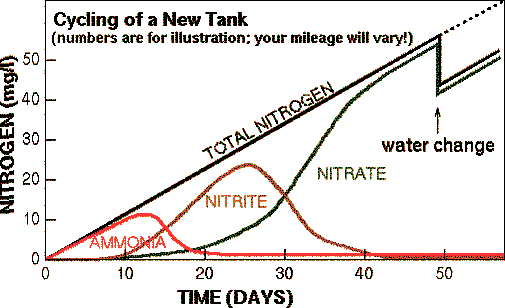
image via rusticgirls
In a freshwater aquarium you can add some flake food, wait a couple weeks, and then you can add fish. In the ocean there is much more involved than mechanical filtration. In fact, 70% of your aquariums filtration relies on the maturity of the live rock. A combination of bacteria, algae, and various invertebrates compose the “live” part of the rock. It takes quite a while to establish an ecosystem, even on a microscopic level. Without a proper understanding of the Marine Cycle, you will be in for a long term battle with parameters and algae. There are six main stages to a properly cycled tank. Follow this guide and you cannot mess up. You will need your basic test kit to test the progress.
Stage 1: Ammonia Cycle
Ammonia is the first thing that forms when something rots. It is a waste product in nearly all creatures as well. Instead of using a fish to start the cycle just use some food. Anything that is all natural and uncooked works just fine. Table shrimp that is uncooked works great. Drop it on the sand so it is in view. The shrimp should begin to rot within a couple hours or more. Let this shrimp rot until it is completely gone. If you are curious what your ammonia levels are, go ahead and take some tests. Keep track of the results as the shrimp rots. The smaller the food gets the more ammonia should be present in your water column and pretty soon should be off the charts. This will stay high for a while, but then start to drop. As soon as the ammonia starts to drop you will see a rise in Nitrite, you are now on the next stage.
Stage 2: Nitrite Cycle
Ammonia when broken down by bacteria becomes Nitrite, which is still a toxin. As your Nitrites rise your Ammonia will drop, drop, and keep dropping as long as you haven’t added any animals. Keep up with testing to observe your progress. Eventually your Ammonia will be very low and your nitrites will peak out until it starts feeding a different type of bacteria that turns it into Nitrates. Once your first signs of Nitrates are seen you are on the next stage.
Stage 3: Nitrate Cycle
Nitrates are removed within the live rock deep inside in all of the deep pours. This hidden bacteria consumes the nitrate and creates nitrogen gas as a byproduct. The nitrogen gas rises in the water column and escapes into the air. When one gas leave, another enters. Oxygen is then infused into the water. After the Nitrates start to dissipate your oxygen will increase and you will be ready for the intermission:
Intermission:
You are not done yet! You may have cultivated a nice crop of groovy bacteria and your water may be clean as can be, but, there are still 3 more stages to the cycle process before you can start your stocking. Take this time to consume all of which you have already done. The next 3 stages often put fear into the eyes of many newcomers. These are perfectly natural and are partially a representation of how the earth became an oxygen rich planet. Before there was any oxygen breathing organisms, there was the evolution of Cyanobacteria. This is a photosynthetic bacteria that creates Oxygen as a byproduct. There are several colors, but the commonality is that it is like a slime. The Cyanobacteria spread over a vast area and the atmosphere became oxygen rich like we breath today, without the smog. Cyanobacteria is responsible for life as we know it. The same applies to the reef. Now that your mind has been blown you may move on to the next stage of the cycle.
Pre-Algae Cycle:
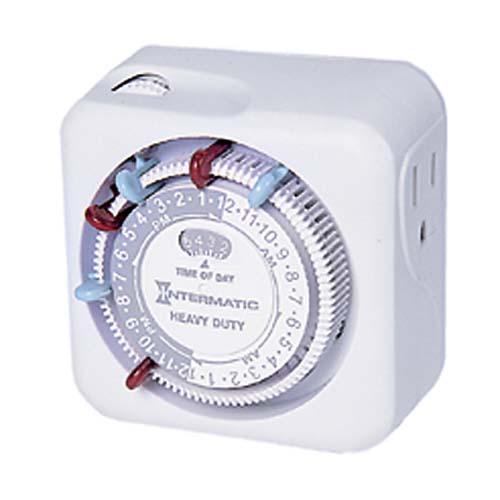
If your lights have not been setup yet do so now. Set your timers as you would for a reef tank. Anywhere from 6-12 hours is a good amount of time. Set the photoperiod to be on during the hours you will be viewing the tank most. If you work 2nd shift it is OK to have the lights come on after you get home from work or when you wake up in the morning. As long as there is not a supply of sunlight near the tank you wont have a long term battle with algae.
Stage 4: Diatoms
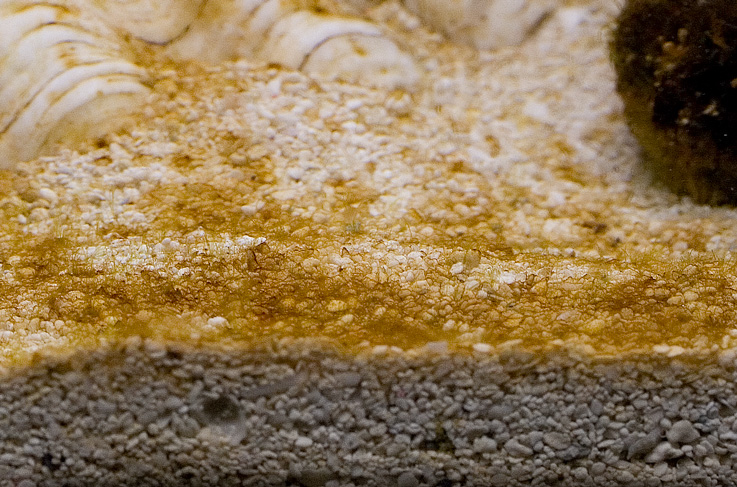
diatom algae image via reef2reef member Steven R
Diatoms are a brown dusty life form that consumes silicates. There is no avoiding Diatoms during their initial bloom. Leave it be. Let it go crazy. Before you know it, the brown stuff will soon start to change colors. Generally red, this is the start of the next stage!
Stage 5: Cyanobacteria
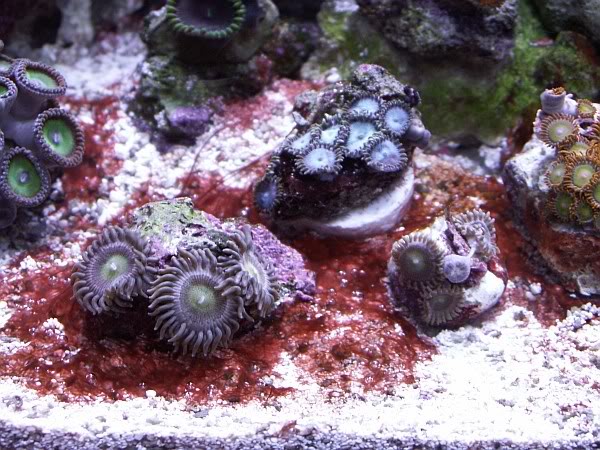
cyanobacteria image via reef2reef member murfman
Cyanobacteria will now begin its course. Again you will let the slime just do its thing. This will be the nastiest of the stages. Cyanobacteria can gross some people out, especially if they catch a whiff of it. It is best to leave it be. It will start to clear up eventually. The clearing of the slime makes way for yet another stage.
Stage 6: Green/Brown algae
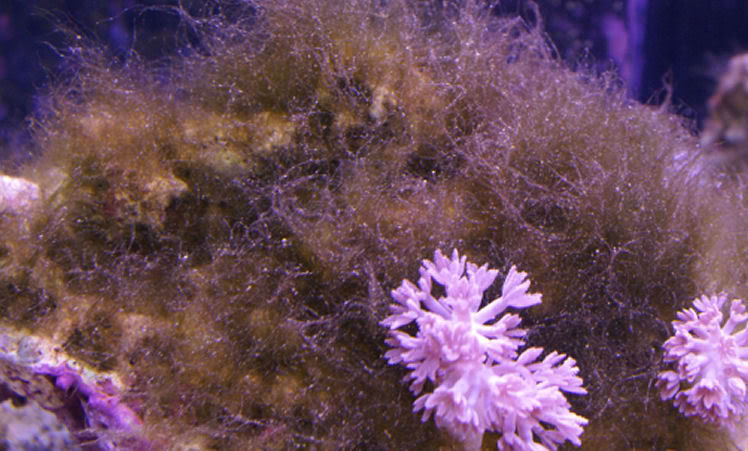
hair algae image via reef2reef member johnmaloney
If you have made it this far, give yourself a round of applause. This is the final “battle” of the cycle process. When the slime is gone you will see your first signs of plant life, algae! Green Hair algae is usually the type that you see, but some other types have been known to occur. This stuff will grow like mad. At this point you are ready to move on to the next phase.
The cycle is a long process in terms of hobbies. Find yourself a good rhythm for testing. Get yourself in the habit of staring for long periods of time. Practice observation by watching as life forms start taking foot in the aquarium. You will see things from dust sized particles to worms that reach a foot long. There really is no telling what could form in your tank. This is a great time to prepare for the animals you will get. Knowing how to describe things and being able to correctly test the water will help you get the information you need. Your parameters are perfect now. You are now ready to move on to the next section. You should actually study the next section during your cycle, since you will have quite a bit of time on your hands with all that waiting.
Cycles can be artificially induced, but it is always preferred to use as little foreign liquids as possible. Another thing you can do during the cycle is preparing your clean up crew and first fish, but be prepared to keep them quarantined for a prolonged time since the cycle is unpredictable.
My suggestion to you is to take your time , this is normal ,you will see all different kinds of algae the first couple of months till it matures.
This is the hardest time when getting your first tank started,patience is the key!
This is the hardest time when getting your first tank started,patience is the key!
Diatom Algae! That's it. I'm calm and all is under control. Thanks KJ...
YWDiatom Algae! That's it. I'm calm and all is under control. Thanks KJ...
Hey Everyone - I now have long green algae that has formed. My question is... What should I do? Let it keep going or try and remove it from the rock/dryed coral? I still do not have any animals and my ammonia is 0 and my nitrites are 0. Nitrates are 10 ppm. I would like to put something in there but I'll be patient as long as it takes.
jsker
Reefing is all about the adventure
View Badges
Staff member
Super Moderator
Partner Member 2024
Excellence Award
Reef Tank 365
Article Contributor
Hospitality Award
Ocala Reef Club Member
R2R Secret Santa 2023
My Tank Thread
Wait for at least 30 days, I know it killing you but wait . Then add the cleaning crew, wait again. Each time you add something wait for the tank to adjust to the new bio load.
. Then add the cleaning crew, wait again. Each time you add something wait for the tank to adjust to the new bio load.
So I go into my LFS last weekend. Young man 1/3 my age looks straight at me and says "your 65 gallon tank is not cycled yet?" My 100 gallon tank cycled in 4 days. You should have put this "snake oil" in it." That's what I call it. I said I'm letting it happen like nature would do it. I said what's the big rush? I mean I really want to look at something cool but I don't want to kill it fish or planimals. So I sit and look at Algae now. .
30 more days is a long time but I'll wait. When should I do my first water change? What Nitrate level is too high?
30 more days is a long time but I'll wait. When should I do my first water change? What Nitrate level is too high?
how much nitrate is too much is different for every reefer and every tank. Most feel that if its safe at levels 20ppm or below.
It really depends on what corals you plan to keep later..
Ive had the best luck and good growth with my corals keeping them under 10ppm.
It really depends on what corals you plan to keep later..
Ive had the best luck and good growth with my corals keeping them under 10ppm.
Similar threads
- Replies
- 12
- Views
- 328
- Replies
- 13
- Views
- 410
- Replies
- 10
- Views
- 210
- Replies
- 19
- Views
- 246
- Replies
- 47
- Views
- 925














